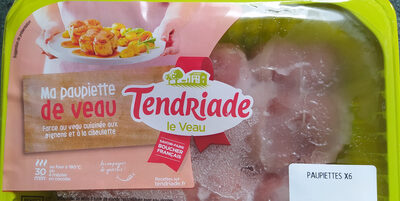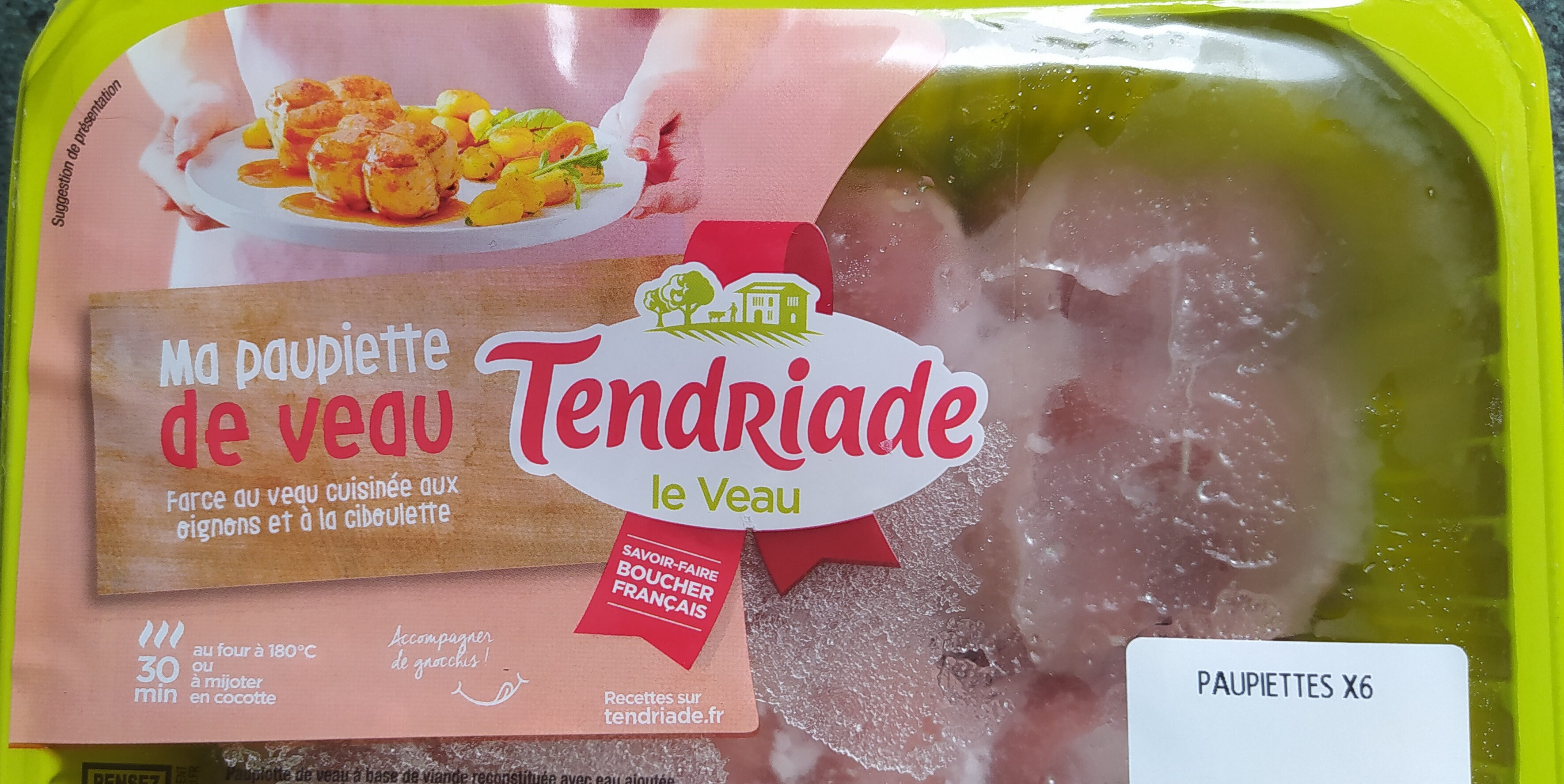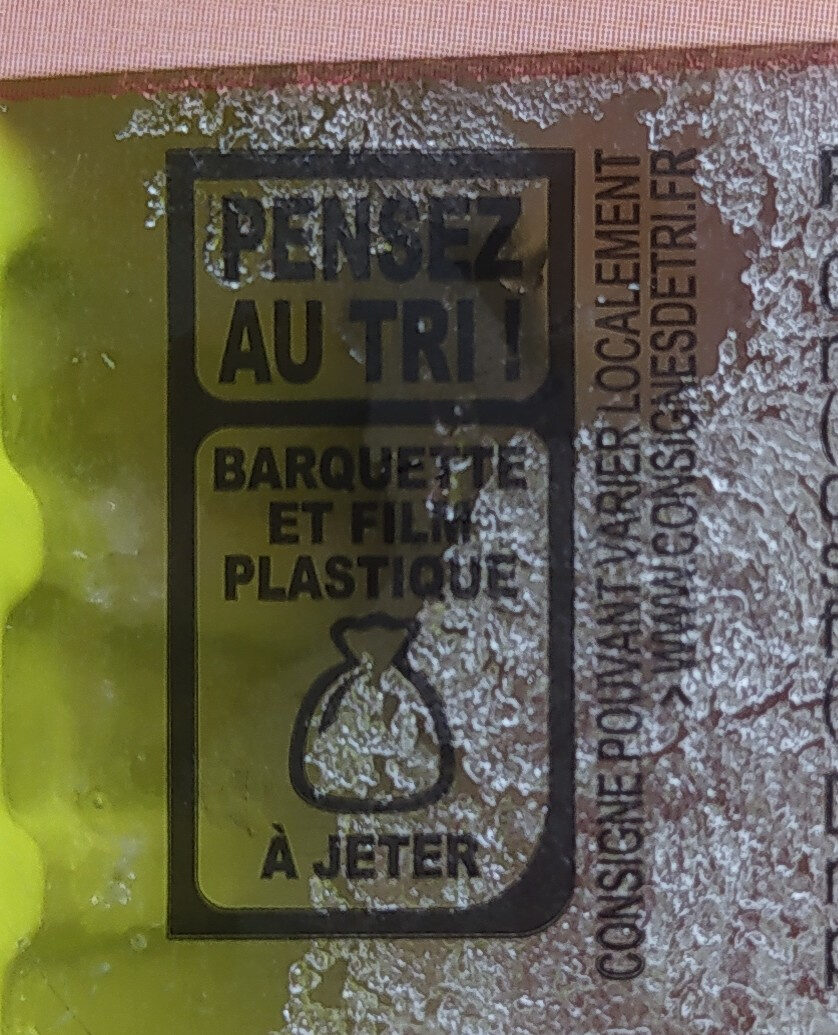Help us make food transparency the norm!
As a non-profit organization, we depend on your donations to continue informing consumers around the world about what they eat.
The food revolution starts with you!
Paupiettes de Veau - Tendriade - 6 x 130 g
Paupiettes de Veau - Tendriade - 6 x 130 g
Barcode: 3384480017701 (EAN / EAN-13)
Quantity: 6 x 130 g
Packaging: Fresh, Tray, fr:Film en plastique
Brands: Tendriade
Categories: Meats and their products, Meals, Meats, Meals with meat, Beef dishes, Veal meat, Olive veal
Origin of ingredients: European Union
Traceability code: FR 26.337.021 CE - Saulce-sur-Rhône (Drôme, France), FR 35.068.002 CE - Châteaubourg (Ille-et-Vilaine, France)
Countries where sold: France
Matching with your preferences
Health
Ingredients
-
29 ingredients
: Viande de porc (36%), viande de veau reconstituée (30.5%). eau. oignon (3,5%), gras de veau, dextrose (BLE), gelifiant: E401,E516, E509, stabilisant: E450, chapelure(BLE), fibres végétales, amidon modifié, acidifiant : E326, E261, sel, vin blanc, blanc d'oeuf OEUF), aromes, protéines(LAIT), ciboulette(0.05%), antioxydant : E316, poudre de betteraveAllergens: Eggs, Gluten, MilkTraces: Soybeans
Food processing
-
Ultra processed foods
Elements that indicate the product is in the 4 - Ultra processed food and drink products group:
- Additive: E14XX - Modified Starch
- Additive: E326 - Potassium lactate
- Additive: E401 - Sodium alginate
- Additive: E450 - Diphosphates
- Ingredient: Dextrose
- Ingredient: Flavouring
- Ingredient: Gelling agent
- Ingredient: Glucose
Food products are classified into 4 groups according to their degree of processing:
- Unprocessed or minimally processed foods
- Processed culinary ingredients
- Processed foods
- Ultra processed foods
The determination of the group is based on the category of the product and on the ingredients it contains.
Additives
-
E261 - Potassium acetate
Potassium acetate: Potassium acetate -KCH3COO- is the potassium salt of acetic acid.Source: Wikipedia
-
E316 - Sodium erythorbate
Sodium erythorbate: Sodium erythorbate -C6H7NaO6- is a food additive used predominantly in meats, poultry, and soft drinks. Chemically, it is the sodium salt of erythorbic acid. When used in processed meat such as hot dogs and beef sticks, it increases the rate at which nitrite reduces to nitric oxide, thus facilitating a faster cure and retaining the pink coloring. As an antioxidant structurally related to vitamin C, it helps improve flavor stability and prevents the formation of carcinogenic nitrosamines. When used as a food additive, its E number is E316. The use of erythorbic acid and sodium erythorbate as a food preservative has increased greatly since the U.S. Food and Drug Administration banned the use of sulfites as preservatives in foods intended to be eaten fresh -such as ingredients for fresh salads- and as food processors have responded to the fact that some people are allergic to sulfites. It can also be found in bologna, and is occasionally used in beverages, baked goods, and potato salad.Sodium erythorbate is produced from sugars derived from different sources, such as beets, sugar cane, and corn. An urban myth claims that sodium erythorbate is made from ground earthworms; however, there is no truth to the myth. It is thought that the genesis of the legend comes from the similarity of the chemical name to the words earthworm and bait.Alternative applications include the development of additives that could be utilized as anti-oxidants in general. For instance, this substance has been implemented in the development of corrosion inhibitors for metals and it has been implemented in active packaging.Sodium erythorbate is soluble in water. The pH of the aqueous solution of the sodium salt is between 5 and 6. A 10% solution, made from commercial grade sodium erythorbate, may have a pH of 7.2 to 7.9. In its dry, crystalline state it is nonreactive. But, when in solution with water it readily reacts with atmospheric oxygen and other oxidizing agents, which makes it a valuable antioxidant.Source: Wikipedia
-
E326 - Potassium lactate
Potassium lactate: Potassium lactate is a compound with formula KC3H5O3, or H3C-CHOH-COOK. It is the potassium salt of lactic acid. It is produced by neutralizing lactic acid which is fermented from a sugar source. It has E number "E326". Potassium lactate is a liquid product that is usually 60% solids but is available at up to 78% solids.Potassium lactate is commonly used in meat and poultry products to extend shelf life and increase food safety as it has a broad antimicrobial action and is effective at inhibiting most spoilage and pathogenic bacteria. Potassium lactate is also used as an extinguishing medium in the First Alert Tundra fire extinguishers.Source: Wikipedia
-
E450 - Diphosphates
Diphosphates (E450) are food additives often utilized to modify the texture of products, acting as leavening agents in baking and preventing the coagulation of canned food.
These salts can stabilize whipped cream and are also found in powdered products to maintain their flow properties. They are commonly present in baked goods, processed meats, and soft drinks.
Derived from phosphoric acid, they're part of our daily phosphate intake, which often surpasses recommended levels due to the prevalence of phosphates in processed foods and drinks.
Excessive phosphate consumption is linked to health issues, such as impaired kidney function and weakened bone health. Though diphosphates are generally regarded as safe when consumed within established acceptable daily intakes, it's imperative to monitor overall phosphate consumption to maintain optimal health.
-
E509 - Calcium chloride
Calcium chloride: Calcium chloride is an inorganic compound, a salt with the chemical formula CaCl2. It is a colorless crystalline solid at room temperature, highly soluble in water. Calcium chloride is commonly encountered as a hydrated solid with generic formula CaCl2-H2O-x, where x = 0, 1, 2, 4, and 6. These compounds are mainly used for de-icing and dust control. Because the anhydrous salt is hygroscopic, it is used as a desiccant.Source: Wikipedia
-
E516 - Calcium sulphate
Calcium sulfate: Calcium sulfate -or calcium sulphate- is the inorganic compound with the formula CaSO4 and related hydrates. In the form of γ-anhydrite -the anhydrous form-, it is used as a desiccant. One particular hydrate is better known as plaster of Paris, and another occurs naturally as the mineral gypsum. It has many uses in industry. All forms are white solids that are poorly soluble in water. Calcium sulfate causes permanent hardness in water.Source: Wikipedia
Ingredients analysis
-
May contain palm oil
Ingredients that may contain palm oil: Calf fat
-
Non-vegan
Non-vegan ingredients: Pork meat, Veal meat, Calf fatSome ingredients could not be recognized.
We need your help!
You can help us recognize more ingredients and better analyze the list of ingredients for this product and others:
- Edit this product page to correct spelling mistakes in the ingredients list, and/or to remove ingredients in other languages and sentences that are not related to the ingredients.
- Add new entries, synonyms or translations to our multilingual lists of ingredients, ingredient processing methods, and labels.
If you would like to help, join the #ingredients channel on our Slack discussion space and/or learn about ingredients analysis on our wiki. Thank you!
-
Non-vegetarian
Non-vegetarian ingredients: Pork meat, Veal meat, Calf fatSome ingredients could not be recognized.
We need your help!
You can help us recognize more ingredients and better analyze the list of ingredients for this product and others:
- Edit this product page to correct spelling mistakes in the ingredients list, and/or to remove ingredients in other languages and sentences that are not related to the ingredients.
- Add new entries, synonyms or translations to our multilingual lists of ingredients, ingredient processing methods, and labels.
If you would like to help, join the #ingredients channel on our Slack discussion space and/or learn about ingredients analysis on our wiki. Thank you!
-
Details of the analysis of the ingredients
We need your help!
Some ingredients could not be recognized.
We need your help!
You can help us recognize more ingredients and better analyze the list of ingredients for this product and others:
- Edit this product page to correct spelling mistakes in the ingredients list, and/or to remove ingredients in other languages and sentences that are not related to the ingredients.
- Add new entries, synonyms or translations to our multilingual lists of ingredients, ingredient processing methods, and labels.
If you would like to help, join the #ingredients channel on our Slack discussion space and/or learn about ingredients analysis on our wiki. Thank you!
: Viande de porc 36%, viande de veau 30.5%, eau, oignon 3.5%, gras de veau, dextrose (BLE), gelifiant (e401), e516, e509, stabilisant (e450), chapelure (BLE), fibres végétales, amidon modifié, acidifiant (e326), e261, sel, vin blanc, blanc d'oeuf OEUF, aromes, protéines, ciboulette 0.05%, antioxydant (e316), betterave- Viande de porc -> en:pork-meat - vegan: no - vegetarian: no - ciqual_proxy_food_code: 28205 - percent_min: 36 - percent: 36 - percent_max: 36
- viande de veau -> en:veal-meat - vegan: no - vegetarian: no - percent_min: 30.5 - percent: 30.5 - percent_max: 30.5
- eau -> en:water - vegan: yes - vegetarian: yes - ciqual_food_code: 18066 - percent_min: 3.5 - percent_max: 29.15
- oignon -> en:onion - vegan: yes - vegetarian: yes - ciqual_food_code: 20034 - percent_min: 3.5 - percent: 3.5 - percent_max: 3.5
- gras de veau -> en:calf-fat - vegan: no - vegetarian: no - from_palm_oil: maybe - percent_min: 0.05 - percent_max: 3.5
- dextrose -> en:dextrose - vegan: yes - vegetarian: yes - ciqual_proxy_food_code: 31016 - percent_min: 0.05 - percent_max: 3.5
- BLE -> en:wheat - vegan: yes - vegetarian: yes - ciqual_proxy_food_code: 9410 - percent_min: 0 - percent_max: 3.5
- gelifiant -> en:gelling-agent - percent_min: 0.05 - percent_max: 3.5
- e401 -> en:e401 - vegan: yes - vegetarian: yes - percent_min: 0 - percent_max: 3.5
- e516 -> en:e516 - vegan: yes - vegetarian: yes - percent_min: 0.05 - percent_max: 3.5
- e509 -> en:e509 - vegan: yes - vegetarian: yes - percent_min: 0.05 - percent_max: 3.5
- stabilisant -> en:stabiliser - percent_min: 0.05 - percent_max: 3.5
- e450 -> en:e450 - vegan: yes - vegetarian: yes - percent_min: 0 - percent_max: 3.5
- chapelure -> en:breadcrumbs - vegan: maybe - vegetarian: maybe - ciqual_food_code: 7500 - percent_min: 0.05 - percent_max: 3.33333333333333
- BLE -> en:wheat - vegan: yes - vegetarian: yes - ciqual_proxy_food_code: 9410 - percent_min: 0 - percent_max: 3.33333333333333
- fibres végétales -> en:vegetable-fiber - vegan: yes - vegetarian: yes - percent_min: 0.05 - percent_max: 3
- amidon modifié -> en:modified-starch - vegan: yes - vegetarian: yes - ciqual_proxy_food_code: 9510 - percent_min: 0.05 - percent_max: 2.72727272727273
- acidifiant -> en:acid - percent_min: 0.05 - percent_max: 2.5
- e326 -> en:e326 - vegan: yes - vegetarian: yes - percent_min: 0 - percent_max: 2.5
- e261 -> en:e261 - vegan: yes - vegetarian: yes - percent_min: 0.05 - percent_max: 2.30769230769231
- sel -> en:salt - vegan: yes - vegetarian: yes - ciqual_food_code: 11058 - percent_min: 0.05 - percent_max: 0.98
- vin blanc -> en:white-wine - vegan: maybe - vegetarian: yes - ciqual_food_code: 1014 - percent_min: 0.05 - percent_max: 0.98
- blanc d'oeuf OEUF -> fr:blanc-d-oeuf-oeuf - percent_min: 0.05 - percent_max: 0.98
- aromes -> en:flavouring - vegan: maybe - vegetarian: maybe - percent_min: 0.05 - percent_max: 0.98
- protéines -> en:protein - vegan: maybe - vegetarian: maybe - percent_min: 0.05 - percent_max: 0.98
- ciboulette -> en:chives - vegan: yes - vegetarian: yes - ciqual_food_code: 11003 - percent_min: 0.05 - percent: 0.05 - percent_max: 0.05
- antioxydant -> en:antioxidant - percent_min: 0 - percent_max: 0.05
- e316 -> en:e316 - vegan: yes - vegetarian: yes - percent_min: 0 - percent_max: 0.05
- betterave -> en:beetroot - vegan: yes - vegetarian: yes - ciqual_proxy_food_code: 20091 - percent_min: 0 - percent_max: 0.05
Nutrition
-
Poor nutritional quality
⚠ ️Warning: the amount of fruits, vegetables and nuts is not specified on the label, it was estimated from the list of ingredients: 3This product is not considered a beverage for the calculation of the Nutri-Score.
Positive points: 0
- Proteins: 5 / 5 (value: 11.1, rounded value: 11.1)
- Fiber: 0 / 5 (value: 0, rounded value: 0)
- Fruits, vegetables, nuts, and colza/walnut/olive oils: 0 / 5 (value: 3.55, rounded value: 3.6)
Negative points: 12
- Energy: 2 / 10 (value: 891, rounded value: 891)
- Sugars: 0 / 10 (value: 0.7, rounded value: 0.7)
- Saturated fat: 6 / 10 (value: 6.6, rounded value: 6.6)
- Sodium: 4 / 10 (value: 392, rounded value: 392)
The points for proteins are not counted because the negative points are greater or equal to 11.
Nutritional score: (12 - 0)
Nutri-Score:
-
Nutrient levels
-
Fat in moderate quantity (16.7%)
What you need to know- A high consumption of fat, especially saturated fats, can raise cholesterol, which increases the risk of heart diseases.
Recommendation: Limit the consumption of fat and saturated fat- Choose products with lower fat and saturated fat content.
-
Saturated fat in high quantity (6.6%)
What you need to know- A high consumption of fat, especially saturated fats, can raise cholesterol, which increases the risk of heart diseases.
Recommendation: Limit the consumption of fat and saturated fat- Choose products with lower fat and saturated fat content.
-
Sugars in low quantity (0.7%)
What you need to know- A high consumption of sugar can cause weight gain and tooth decay. It also augments the risk of type 2 diabetes and cardio-vascular diseases.
Recommendation: Limit the consumption of sugar and sugary drinks- Sugary drinks (such as sodas, fruit beverages, and fruit juices and nectars) should be limited as much as possible (no more than 1 glass a day).
- Choose products with lower sugar content and reduce the consumption of products with added sugars.
-
Salt in moderate quantity (0.98%)
What you need to know- A high consumption of salt (or sodium) can cause raised blood pressure, which can increase the risk of heart disease and stroke.
- Many people who have high blood pressure do not know it, as there are often no symptoms.
- Most people consume too much salt (on average 9 to 12 grams per day), around twice the recommended maximum level of intake.
Recommendation: Limit the consumption of salt and salted food- Reduce the quantity of salt used when cooking, and don't salt again at the table.
- Limit the consumption of salty snacks and choose products with lower salt content.
-
-
Nutrition facts
Nutrition facts As sold
for 100 g / 100 mlCompared to: Olive veal Energy 891 kj
(213 kcal)-6% Fat 16.7 g -7% Saturated fat 6.6 g -8% Carbohydrates 4.2 g +60% Sugars 0.7 g +17% Fiber 0 g Proteins 11.1 g -18% Salt 0.98 g +7% Fruits‚ vegetables‚ nuts and rapeseed‚ walnut and olive oils (estimate from ingredients list analysis) 3.55 % Carbon footprint from meat or fish 891.65 g
Environment
-
Eco-Score E - Very high environmental impact
⚠ ️Select a country in order to include the full impact of transportation.The Eco-Score is an experimental score that summarizes the environmental impacts of food products.→ The Eco-Score was initially developped for France and it is being extended to other European countries. The Eco-Score formula is subject to change as it is regularly improved to make it more precise and better suited to each country.Life cycle analysis
-
Average impact of products of the same category: E (Score: 15/100)
Category: Veal olive or veal paupiette
Category: Veal olive or veal paupiette
- PEF environmental score: 1.80 (the lower the score, the lower the impact)
- including impact on climate change: 17.28 kg CO2 eq/kg of product
Stage Impact Agriculture
91.9 %Processing
3.6 %Packaging
1.1 %Transportation
0.9 %Distribution
0.5 %Consumption
1.9 %
Bonuses and maluses
-
Origins of ingredients with a high impact
Malus: -5
Environmental policy: -5
Transportation: 0
Origin of the product and/or its ingredients % of ingredients Impact European Union 100 %High
-
Packaging with a medium impact
Malus: -11
Shape Material Recycling Impact Film Plastic High Tray Unknown High ⚠ ️ The information about the packaging of this product is not sufficiently precise (exact shapes and materials of all components of the packaging).⚠ ️ For a more precise calculation of the Eco-Score, you can modify the product page and add them.
If you are the manufacturer of this product, you can send us the information with our free platform for producers.
Eco-Score for this product
-
Impact for this product: E (Score: -1/100)
Product: Paupiettes de Veau - Tendriade - 6 x 130 g
Life cycle analysis score: 15
Sum of bonuses and maluses: -16
Final score: -1/100
-
Carbon footprint
-
Equal to driving 9.0 km in a petrol car
1728 g CO² per 100g of product
The carbon emission figure comes from ADEME's Agribalyse database, for the category: Veal olive or veal paupiette (Source: ADEME Agribalyse Database)
Stage Impact Agriculture
94.7 %Processing
2.0 %Packaging
1.3 %Transportation
1.2 %Distribution
0.2 %Consumption
0.5 %
Packaging
-
Packaging with a medium impact
-
Packaging parts
Film (Plastic)
Tray
-
Packaging materials
Material % Packaging weight Packaging weight per 100 g of product Plastic
-
Transportation
-
Origins of ingredients
Origins of ingredients with a high impact
Origin of the product and/or its ingredients % of ingredients Impact European Union 100 %High
Report a problem
-
Incomplete or incorrect information?
Category, labels, ingredients, allergens, nutritional information, photos etc.
If the information does not match the information on the packaging, please complete or correct it. Open Food Facts is a collaborative database, and every contribution is useful for all.
Data sources
Product added on by bebone
Last edit of product page on by packbot.
Product page also edited by aleene, beniben, bojackhorseman, date-limite-app, floriane-yuka, kiliweb, marktend, openfoodfacts-contributors, roboto-app, sasa, teolemon, yuka.WUsxZkY0c2xsNmhUbmRwanowbncwTklzM2JTeWZEeXZjTVVJSVE9PQ.













